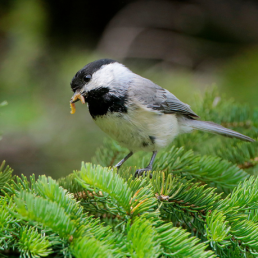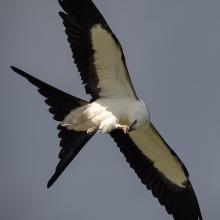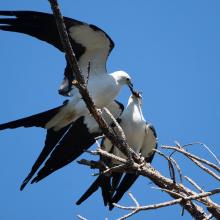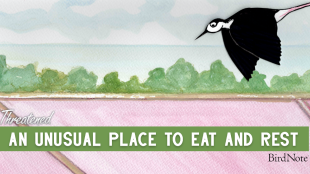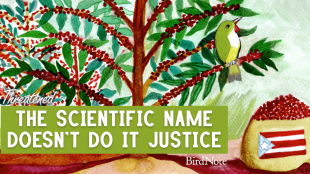

Join BirdNote tomorrow, November 30th!
Illustrator David Sibley and actor H. Jon Benjamin will face off in the bird illustration battle of the century during BirdNote's Year-end Celebration and Auction!
Despite the odds, The Joe Farm in Newbern, Alabama, creates a safe space for birds and birders.
In the Black Belt region of Alabama, we go on a birding tour and learn about the Swallow-tailed Kite. The Swallow-tailed Kite’s range in this region decreased rapidly over the past one hundred years, primarily due to habitat loss from agriculture, urban development, and logging. Now protected by the State of Alabama, we visit a family farm where the kites are frequently seen and learn how the ensuing curiosity about the birds has brought new opportunities. Producer Jay Avery brings us this story of a threatened bird, an historically excluded human community, and how they are helping each other.
Ari Daniel: BirdNote presents.
Christopher Joe: [in the field with a crowd] Hey, is that a Chimney Swift? There’s another one!
[crowd reaction]
[random chatter]
[theme music]
Ari Daniel: Hey, I’m Ari Daniel, and this is Threatened. In this episode, we travel to Alabama, to a region called the Black Belt to learn about the Swallow-tailed Kite and a safe space that’s been created for both the bird ... and the birders. This story comes to us from Jay Avery, who went to this place, called The Joe Farm. Jay, what do we need to know before we get started?
Jay Avery: Well, Ari, you know last year Black birders started getting a lot of attention, and as I was hearing about them in the news it really connected with me and in particular this concept of “sankofa”.
Ari Daniel: Sankofa. I’ve never heard that word before, what does it mean exactly?
Jay Avery: As a Black person, I’d heard the term throughout my life. Its literal meaning is “to retrieve,” and the idea behind it is incredibly powerful. Sankofa is represented by an image of a bird. The bird has its feet facing forward but its head is curving back. The deeper meaning of sankofa is “it is not wrong to go back for that which you have forgotten.” Even as we move forward, we look back to the lessons of yesterday. The word sankofa comes from the Akan language in Ghana, West Africa. I actually got to travel there and the word took on an even deeper meaning for me.
Ari Daniel: When was that, Jay?
Jay Avery: It was five years ago.
Ari Daniel: And you said the word took on a deeper meaning for you?
Jay Avery: Yes, well, my ancestors were stolen from Ghana and Nigeria, and my own return to West Africa centuries later showed me that some things that were lost could be reclaimed.
Ari Daniel: What do you mean by that?
Jay Avery: You know, it was interesting. One day in Accra, Ghana, my friend and I stopped by a restaurant. While eating, I was struck by how familiar the flavors and textures were to soul food back home in North Carolina. It was one of many reminders that, while much has been lost, African Americans have preserved more throughout history than we may even think. We can hold onto that as we look towards the future.
So I had sankofa on my mind as I traveled to Alabama to explore a story of Blackness in birding. The mythical sankofa bird led to the very real Swallow-tailed Kite, and the challenges that it faces.
Jay Avery: It’s early morning here in Newbern, Alabama. I’m about 45 minutes from Selma, where, nearly 60 years ago, the late Rep. John Lewis led a group of Civil Rights activists over the Edmund Pettus Bridge, in what would later be known as Bloody Sunday. As I weave down central Alabama’s long-winding country roads, surrounded by a maze of fields, I arrive at my destination: The Joe’s Black Angus Farm.
Christopher Joe: we roughly have, uh, 200 acres with about six miles of trails.
Jay Avery: Christopher Joe, founder of the birding experiences on the Joe family property, is here to greet me.
Christopher Joe: Nature in general is what a lot of people are, are looking for in places like this, to where they can come and relax.
Jay Avery: Christopher is a third generation Black Angus cattle farmer, and that’s still his primary work. But he started Birds and Nature Tours in February 2019, and he’s been going strong ever since.
Christopher Joe: The summer months are my busiest months. And we normally get roughly groups this size. So it's, it's kinda kind of fun to see who's all coming. So this group is from Atlanta.
Jay Avery: The group here today has about 20 people— they’re called The GAGL, which is an acronym for The Greater Atlanta Gay and Lesbian Birders, and they travel to various locations for the bird life. The variety of species at the Joe’s Farm enticed them to visit Alabama to join today’s tour. Here’s one of the birders from the GAGL:
GAGL member: People say, well, I really just like flowers. I say, well, if you can imagine a flower, all different kinds of colors that flies and sings.
Jay Avery: The group has already seen a lot of birds today:
Christopher Joe: Bald Eagle, Black Vulture, Summer Tanager, Chimney Swift....
Jay Avery: We’ll spare you, this list goes on for awhile.
Christopher Joe: and Mississippi Kite. So that's, what's flying around right now, which they're about six with one, two, three...
Jay Avery: Today, they’re firing up the tractor to cut the hay … which may better be described as a “kite extravaganza.”
Christopher Joe: The grasshoppers, when we started cutting that field, then we'll just have y'all sit there. They're going to start coming down and it is amazing.
Second voice: They do acrobats.
Christopher Joe: It is amazing.
Jay Avery: There are Swallow-tailed Kites in Central and South America that live there year-round… but there’s also a subspecies that migrates to the US. Of that group, there’s only a few thousand that remain.
A few hundred years ago, migratory populations of Swallow-tailed Kites bred or nested in 21 states, as far north as Wisconsin. Today, the bird nests in only a third of those states, and is listed as endangered, threatened or of conservation concern in almost all of them, including Alabama. And on this visit to the farm we spot Mississippi Kites. So far none of the Swallow-tailed Kites have made an appearance. But Christopher’s brother, Cornelius Junior, tells me what they’re like:
Cornelius Joe Jr.: So, a Swallow-tailed Kite is like a fighter jet. Like we have fighter jets in our armory that they wish they could do what that bird can do. He uses his back tail like a rudder, it's basically a diamond shape cut real thin on each side, and then sort of, almost like a plane wing. They are spectacular birds. They eat on the wing. They don't land. So they literally can catch their prey in mid-flight. Catch it in mid-flight, eat it, and just keep flying.
Jay Avery: You can see why they’re popular visitors to the Joes’ farm, where they return every year. During a hay-cutting, bugs are startled from their hiding places. The Swallow-tailed Kite can then swoop in for a feast. In Alabama, the kite breeds between mid-March and early July, after which they migrate to South America. The Joes’ land has been a safe haven for Swallow-tailed Kites, as there are plenty of pine and cypress trees, their natural habitat. The farm also provides forest edges and open fields, which the kites need to forage during breeding season. Here’s Christopher again:
Christopher Joe: This habitat is almost your wood, um, pasture type. So you'll see in it a lot of the shrubs, small shrubs and bushes.
Jay Avery: The land we’re standing on has been in the Joe family since the 1900s. It was previously the site of cotton plantations where enslaved Black people toiled their lives away, unable to freely enjoy the beauty of the nature currently surrounding us. It’s called the Black Belt of Alabama:
Christopher Joe: The Black Belt is a historical place, because settlers from the North came down and saw that the soil was very rich, and that's why they call it the Black Belt. And that’s why cotton grew so well. A lot of the cotton grown here was put on riverboats in the Black Warrior River and sent down to Mobile on riverboats, and that cotton went back to England.
Jay Avery: Although the “black belt” initially started in reference to the soil, it later took on additional meaning as more enslaved Black people were sent to the region. Booker T. Washington wrote in his autobiography that, quote, “Especially since the Civil War, the term ‘Black Belt’ was used wholly in a political sense: that is, to designate the counties where the Black people outnumber the white.”
Christopher Joe: That trade, it kind of was a good and a bad thing, because it brought a lot of people to Alabama, but also brought a lot of slaves and that ... you know, that's what was down here.
Jay Avery: That the Joes were able to purchase land as a Black family in the early 1900s, and retain ownership of the land throughout the century, is very significant. African Americans lost about 12 million acres of farmland in a little more than a century. That’s about the equivalent of Vermont and New Hampshire combined. There are many reasons for this. Black people had difficulty accessing legal counsel, so even if they did own land, many died without wills or any form of estate protection — so that land wasn’t passed on to their descendents. And being able to even buy land in the first place was also extremely difficult for Black people across the South, because of white terrorism, discriminatory practices in real estate, and the unjust interpretation of laws by courts. But Christopher’s great-grandfather was able to buy land. Here’s Cornelius Senior, Christopher’s father:
Cornelius Joe Sr.: I imagine back during the time when my granddaddy bought it, land was probably pretty cheap at that point. And I saw on the church cornerstone, it was 1882, and my granddad was a deacon at the church. So, I'm sure things were pretty tough then, but then people had a little ingenuity. I imagine land was probably going for a couple of dollars, an acre, you know, back then.
Jay Avery: Church was a place of, not only spiritual expression, but also community organizing. Resources, knowledge, and connections were all shared at church, within farmers groups, and within other organizations. These collective efforts were invaluable in helping Black people locate, negotiate for, and maintain land. At the time when the Joe family was buying land, most Black families across the South were sharecroppers. Sharecropping was an oppressive system closely related to slavery. People would live and work on land they didn’t own in exchange for a share of the crop, trapping them in an exploitative cycle. But if you owned the land, you could work for yourself. And there was freedom in that. Here’s Leola, Christopher’s mother:
Leola Pickens Joe: I can tell you that I was Leola Pickens before I was Leola Pickens Joe. So the Pickens family have always had … our forefathers have always had land, okay. And we kept it. I was just brought up that way.
Jay Avery: While Black sharecroppers were at the mercy of the owners of the land they were working, Black landowners had more control over their destinies. Part of this was being able to continue going to school while their sharecropper peers could not.
Leola Pickens Joe: And then my friends at school, they had to stay out of school cause they were on somebody else’s property and they had to do such and such chores and stuff like that. And we didn’t know. “Hey, we can do this tomorrow at school.” “Well, I won’t be to school tomorrow.” Cause most times school starts in August, and September is cotton picking. You're getting the last of the cotton picking. And people that lived on that type property had to pick cotton. Well, my mom said, “You’re going to school!” And I wanted to play out in the field, but hey, I didn't know what I would have been missing, you know. But my mom said, “You got to go to school.” So that's what I did. So that was the Pickens family. And that's how I grew up.
Jay Avery: So both Leola and Cornelius had the shared experience of their families owning the land they were growing up on… and the advantages that came with that.
Leola Pickens Joe: But then when I met him, the Joe family, they grew up the same way we grew up. On their forefathers property and they all worked for themselves and whatever they got was fun for them. And that's how they came up. And so, Cornelius, as we had our children and stuff, he said, “Well, I tell you like this, we are not going to be having this land to go to nobody else.”
Ari Daniel: After the break, how this special place for the Joes became just as special to the birds.
MIDROLL
Jay Avery: Just as the Joes have found safety and solace on their land in Alabama, so has the Swallow-tailed Kite. In the U.S., the range of the Swallow-tailed Kite rapidly decreased over the past hundred years, primarily due to loss of habitat from agriculture, urban development, and logging -- though a stable population continues to breed in Florida. The bird is now protected by the State of Alabama. Christopher’s father, Cornelius Sr., tells me about the first time he saw the Swallow-tailed Kite visiting their farm:
Cornelius Joe Sr.: I noticed them when they first came in. I was out cutting hay and it’s always getting tiresome. You can see, going round around the circle on a place, that can get kind of tiresome. And all of a sudden, some of those kites flew in. Oh, they were just dive-bombing the grasshoppers. And it was fun. So that made my day.
Jay Avery: The Swallow-Tailed kite would have attracted Cornelius Sr.’s attention immediately because it is such a striking bird. Its head, inner wings, and underbelly are white, and its outer wings and tail are black. It has a severely forked tail, which helps it to glide. It’s also high up on the list for many birders. Once the team at Alabama Audubon heard about Christopher’s tours, they rushed to the Joe family land to witness it for themselves. Here’s Meg Ford with Alabama Audubon:
Meg Ford: Chris observed that there were people from Alabama Audubon that were coming to his farm to just kind of look over the fence while they were cutting hay. So Chris took the initiative to reach out to us, to ask, like, “Hey, I’ve noticed there are people on the street just looking at my farm.” And just to learn a bit more information. And then, from there, he made the decision to create his ecotourism business. So it was all Chris. It was totally Chris-driven, and we’re just his biggest cheerleaders.
Jay Avery: Meg’s work focuses on the Black Belt specifically. This is personally significant for her.
Meg Ford: The Black Belt is, by and large, Black farmers and Black citizens, most of which are Black farmers and Black people that work in agriculture. I think the demographic officially is about 60% of Alabama’s Black Belt is people of color. So, there’s this interesting need in the birding community for more people of color to be visible in conservation work, even though there’s already tons of Black people already doing conservation work. But being able to be in this position and really advocate for birding for people of color, and Black women in particular, especially with the social challenges that so many people of color and women in general face, trying to make those decisions about, like, “Do I want to go birding by myself?” for instance.
Jay Avery: As the Swallow-tailed Kite fights to survive and thrive, another battle is raging in the human world. Much like the kite, Black birders are also threatened. Historically, African Americans have been excluded from enjoying the rest and restoration that is found in nature. From being forced to work outdoors on plantations throughout the South, to Jim Crow laws excluding African Americans from public parks and beaches, America has colonized even the great outdoors for centuries. This included the establishment of laws and social frameworks that determined who was supposedly worthy of experiencing the fullness of nature’s beauty, which shut Black people out.
News report: Christian, a 57-year-old Harvard-educated science editor, was birdwatching in a wooded area of New York’s Central Park called The Ramble when he encountered a woman whose dog was loose.
Christian Cooper: I said, “Excuse me, ma’am, but dogs in The Ramble have to be on the leash at all times.”
News report: But Christian Cooper says the woman knew exactly what to say to get police to respond.
Christian Cooper: She was going to tap into a deep, deep, dark vein of racism, of racial bias that runs through this country, and has for centuries.
Woman: I’m being threatened by a man in The Ramble, please send the cops immediately!
Jay Avery: In just a few weeks, Christian Cooper will be visiting the Joe’s farm to photograph kites and support the work that Christopher is doing to create safe spaces for Black birders. I caught up with Christopher on the phone to talk more about what he hopes to achieve with his birding tours:
Christopher Joe: So I feel like, you know, I'm kind of like a Green Book, creating safe spaces. Like, Where do I go where I don't have to feel like I got to look over my shoulder, I got to wear the right thing, I can't be looking suspicious. And even if you're not, that's the thing with Christian Cooper, even if you follow all these steps, there's still a possibility that you're going to run into somebody that don't want you in the same space that they are.
Jay Avery: Christopher and his family turned what was once grounds used for the abuse and exploitation of enslaved Black people into a space for Black people, and all people, to find solace and safety in nature. Meg recalls a specific example of this that stood out to her.
Meg Ford: The last time that I went to a public Joe Farm event, they have three or four of those a year, there was a woman that I met that actually came to visit from Georgia. And she was a Black woman, and she was with her daughter. And she was talking about how comfortable that she felt at the Joe Farm, being with the group and everything like that. And how much more comfortable she felt being there than just kind of birding by herself.
But then on top of that, they actually camped out at the Joe Farm the night before. So they were talking about how it rained the night, that night before, and it was muddy, but that they felt extremely safe, which I just thought was so powerful coming from a Black mom.
You know, Black women obviously face so many safety issues, even when we're not out in the woods by ourselves. And I thought that that was really incredible, that she just felt comfortable at the Joe Farm.
Jay Avery: But maintaining safe spaces hasn’t always been easy. Many Southern Black millennial owners of family land have stories that were passed down from parents and grandparents about what it took to protect the land from the terrorism inflicted by the KKK. Christopher is no exception.
Christopher Joe: The Klan was trying to pretty much steal the land from my grandparents. The house was burned. They made attempts to force them into selling land. And they kind of held on, and there was more than one set of family members, and they just held on to it.
Jay Avery: The kite is a majestic bird, gliding on the wind, rarely even flapping its wings. But its migratory track isn’t so smooth. In early fall, it’ll migrate to South America. Its 5,000-mile route is treacherous and uncertain due to storm threats and high winds. The Avian Research and Conservation Institute has been tracking several kites for years, with the most recent group consisting of 16 birds. Out of that number, 2-3 are expected to not survive migration. But in the summer, migratory Swallow-tailed Kites return to their breeding grounds in the U.S. And hopefully a few will always find their way back to the Joes’ Farm.
Conservation efforts to stabilize the kite’s existing population continue across the Southeast, such as the management efforts to protect the bird’s habitat, aided by people like Christopher and the Joe family. In this way, the land has been a safe space for both people and birds, which is a powerful testament to the spirit of sankofa: to keep moving forward while honoring what is behind.
[theme music]
Ari Daniel: The Joe family has been able to maintain their piece of land for over a century, creating a habitat that’s favorable for birds, livestock, and their community. In our next episode we’ll explore what happens to a place when the toxic byproducts of industry contaminate both private and public lands. Lots of birds are helping us humans figure out if the cleanup efforts are on the right track.
Nate Kohler: If you build it and if you build it right, the birds will come.
Ari Daniel: That’s next week on Threatened.
This episode was produced by Jay Avery and me, Ari Daniel, and edited by Caitlin Pierce of the Rough Cut Collective. Audio mix by Rob Byers, Johnny Vince Evans, and Michael Raphael of Final Final V2. Our theme song and original music were composed by Ian Coss, with additional music by Blue Dot Sessions. Threatened is a production of BirdNote and overseen by Content Director Allison Wilson with production assistance from Sam Johnson. You can find our show notes with additional resources, BirdNote’s other podcasts, and much more at BirdNote dot org. Thanks for listening, I’ll see you next time.
